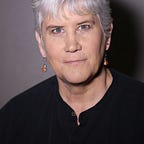The “Vision” in Visionary Leadership
The words, “visionary leadership” are frequently bandied about but what do they mean?
If we characterize a visionary leader as someone who has vision or foresight, then it is worth considering whether we are talking about physical eyesight — the ability to see the expression on another person’s face, the eyesight to recognize the beauty in the world amongst the ugliness, or to literally differentiate the pattern of opportunities from dysfunction.
How is your eyesight? Can you find comfort and a sense of inclusion in the ways in which you are similar to those around you and learn from unique individuals who are very different from you?
Often we don’t see how we are connected in unexpected ways. Our expectation literally changes our ability to see, recognize and interpret the light waves coming our way. A few years ago, a three-year-old with blond hair, the color of corn silk drawled in her Virginia accent, “your hair and my hair are the same.” My brown hair, had started to go grey when I was twenty, by the time I was 50, it was completely white. I smiled at her and said, “honey, I wish that were true.”
She could see a connection, where I did not. There are times when I forget to look for the similarities. I get comfortable hiding, camouflaging the parts of myself that I am not at ease with. I start thinking, as long as I don’t move, grow, or learn, I can keep myself safe from feeling alone, misunderstood and different.
Sure, I can focus on the ways in which we are different. Perhaps you are a man, and that differentiates you from half of the seven billion human beings on this planet. The earth is also half full of women and I can look at the ways in which I am the same as them. Three and a half billion is an awful lot of people to share something in common with. Although I don’t think I look at all like a chimpanzee, I share 98.5 percent of my DNA sequences with chimpanzees, so my similarity with you and with other human beings is even greater.
You and I and she are the same. I know, I know, I said we are not the same and I don’t know you. I do know something about you though. You are human and just that connects us on some level to the other seven billion people on this planet. You understand English, along with up to 1.5 billion other people.
And yet I am also unique. There is only a one in seven billion chances that a living person on planet earth was born in Provo, Utah, USA, to an international businessman and an artist, and grew up in Los Angeles, California; Bogota, Colombia; Brussels, Belgium, and then lived in Tokyo, Japan, Toronto, Canada, who found herself in Tel Aviv, Israel on September 11th, 2001 after a magnificent scuba diving trip in Egypt. It is a unique combination of events and circumstances, which influences how I “look” to you, but each place, each node of my life, provides a potential intersection, something we have in common. A reason, if you will, for why you and I don’t have to feel alone, different, or alienated from each other.
No one ever says, “I feel normal. I fit perfectly here.” Everyone wants to feel safe, and no one does. That has to change because when all seven billion of us feels like we fit, we will have global peace and the abundance each one of us seeks for ourselves and our families.
I See You.
Here is a simple exercise to change how you “see people”.
How Are You and I The Same Game
This exercises is great for eliminating depression and alienation. It can also raise self-esteem and a sense of belonging and contribution in a team. If you are a business leader trying to create better professional relationships, do this for yourself and see what changes in your relationship not only to your colleagues and customers, but with everyone else as well.
Also while doing this, best to keep in mind the saying,
“People change all the time, but you — you can’t change them.”
Part One:
Every day for a week, spend five minutes thinking about the people who are most important in your life. Make a list of the ways in which you are similar or connected. Each day add something new.
Part Two:
During the week for every person you come in contact with, consciously fill in the blank (quietly to yourself or you can tell someone):
You and I are the same because we both are / have _____________.
You can fill in the blank with whatever you want. You might be the same height, or members of the same community or have the same color hair or the same number of children or the same color car.
For people you know well you can fill in the blank with deeply personal characteristics or for the stranger you can fill in a sensation, something you see, hear, or can touch.
And sometimes when you are in a hurry you might fill in the blank with five fingers or women.
Every person you meet, notice some way in which you are similar, connected, don’t need to feel alone or different.
